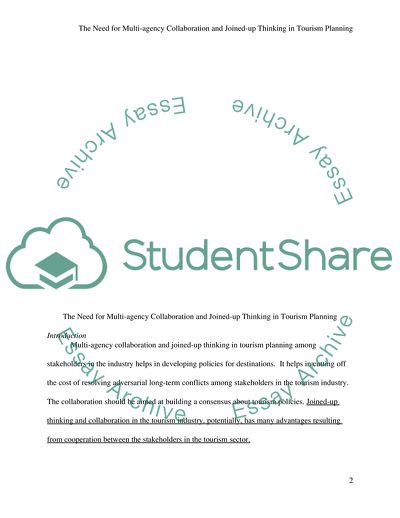Cite this document
(The Need for Multi-Agency Collaboration and Joined-Up Thinking in Tourism Planning Case Study Example | Topics and Well Written Essays - 3750 words, n.d.)
The Need for Multi-Agency Collaboration and Joined-Up Thinking in Tourism Planning Case Study Example | Topics and Well Written Essays - 3750 words. https://studentshare.org/tourism/1818872-critically-discuss-the-need-for-joined-up-thinking-and-multi-agency-collaboration-in-tourism-planning
The Need for Multi-Agency Collaboration and Joined-Up Thinking in Tourism Planning Case Study Example | Topics and Well Written Essays - 3750 words. https://studentshare.org/tourism/1818872-critically-discuss-the-need-for-joined-up-thinking-and-multi-agency-collaboration-in-tourism-planning
(The Need for Multi-Agency Collaboration and Joined-Up Thinking in Tourism Planning Case Study Example | Topics and Well Written Essays - 3750 Words)
The Need for Multi-Agency Collaboration and Joined-Up Thinking in Tourism Planning Case Study Example | Topics and Well Written Essays - 3750 Words. https://studentshare.org/tourism/1818872-critically-discuss-the-need-for-joined-up-thinking-and-multi-agency-collaboration-in-tourism-planning.
The Need for Multi-Agency Collaboration and Joined-Up Thinking in Tourism Planning Case Study Example | Topics and Well Written Essays - 3750 Words. https://studentshare.org/tourism/1818872-critically-discuss-the-need-for-joined-up-thinking-and-multi-agency-collaboration-in-tourism-planning.
“The Need for Multi-Agency Collaboration and Joined-Up Thinking in Tourism Planning Case Study Example | Topics and Well Written Essays - 3750 Words”. https://studentshare.org/tourism/1818872-critically-discuss-the-need-for-joined-up-thinking-and-multi-agency-collaboration-in-tourism-planning.


